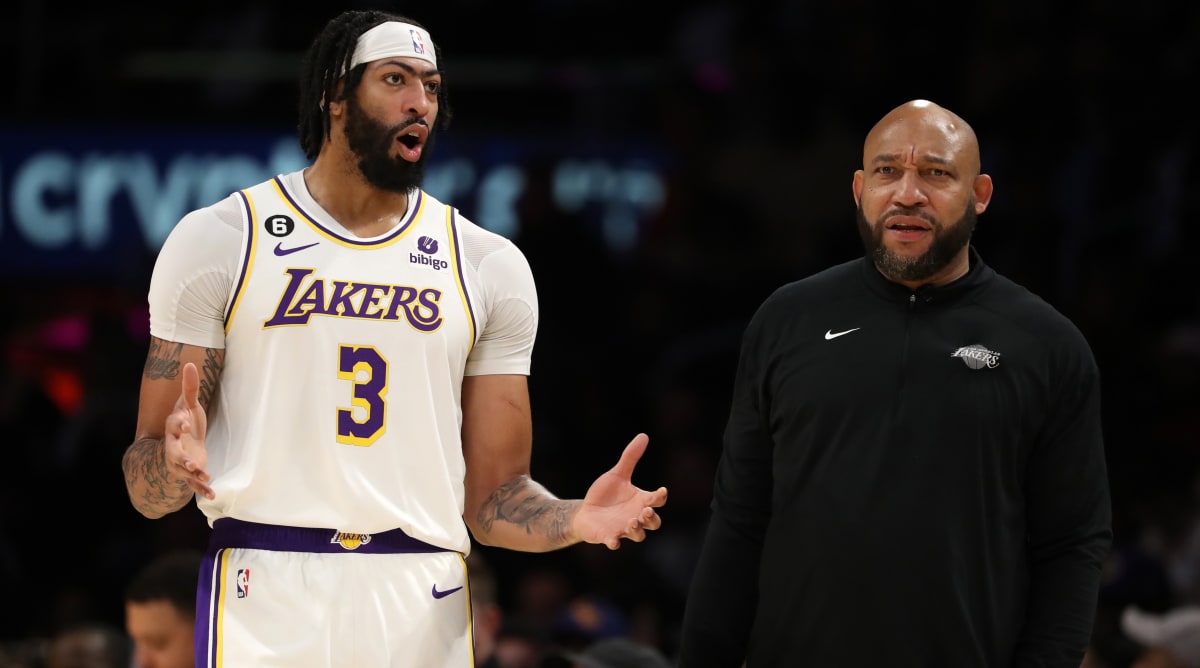A week ago, when Lakers coach Darvin Ham’s comment made waves, it was clear why his remarks drew so much attention.
Ham, who leads a team that improved its depth and three-point shooting prowess perhaps more than any other NBA club this offseason, had said he’d like for superstar Anthony Davis—who’s hit less than 24% of his threes over the past three seasons—to take six triples per game.

Kiyoshi Mio/USA TODAY Sports
On the surface, it was a head-scratcher. Why would the coach of a title contender endorse the idea of a player—even a star like Davis—taking what’s proved to be an inefficient look so often?
In response to the critiques, Ham clarified his stance recently. “People have been going crazy with that number. I think it’s just me saying I want him to be aggressive from all three levels. I don’t want him to think, ‘O.K., man,’ and second-guess his shot,” Ham said. “He catches it and no one’s in front of him, or his defender is off of him, I want him shooting the ball from three.”
Watch the Lakers with Fubo. Start your free trial today.
That added context makes far more sense for any number of reasons. For starters, the team finally enjoys ample spacing a decent amount of the time, putting Davis under less pressure to serve as a stretch big and giving him far more room to operate inside the paint. Even with his unsightly 25.7% mark from deep last season, he still managed to shoot 56.3% from the field overall—buoyed by a career-best 58.9% from two-point range, where he was dominant.
Put another way, it makes far more sense for one of the other, more capable, shooters—like Taurean Prince or even backup big Christian Wood—to increase the club’s three-point diet than it does for Davis to do it in such a targeted fashion.
All that said, Ham’s basic point still made sense, even if it was lost on the average fan or commentator. He wants and needs Davis—one of the league’s most dominant forces, and someone who shot better than 38% from three during the 2020 playoffs in the bubble—to feel a confidence and a green light when he’s left open, something that can carry outsized weight as the season wears on and games take on added importance. His success from the arc in those playoffs was a huge part of why the Lakers won a championship that season.
It’s easy to overlook, but in a way, Nuggets coach Michael Malone seemed to take a similar approach with star guard Jamal Murray this past season. Murray, an explosive scorer in his first season back following an ACL tear, was struggling to find consistency. In an early December game, for instance, Murray shot just 2-for-11 overall—and 0-for-5 from three—in a one-point home loss to the Mavs. His body language throughout the game was poor, so much so that, following the game, he sent Malone a text, saying his mood had been unacceptable in the loss.
Two nights later, Malone gave Murray the rope he needed to play through another challenging performance. Through three quarters against Portland, Murray was just 3-for-10, and 0-for-5 from deep. (He’d missed 14 triples in a row to that point, in fact.) Rather than sub him out, though, Malone stayed with him in the fourth, which paid off when Murray went off for 14 points in the period, including a cold-blooded trey that turned out to be a game-winner.
It goes without saying how last season turned out for Murray, Malone and the Nuggets. But the anecdote is just a glimpse into how and why Ham’s comment about Davis makes a lot of sense, even if the initial details of it sounded strange. There’s enormous potential value in building back a star player’s confidence, whether it’s after an injury or subpar shooting marks in the past.







